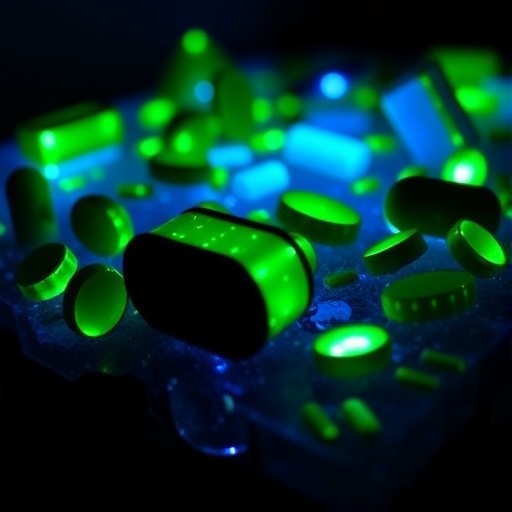In a groundbreaking study published in International Microbiology, researchers explored the impact of varying photonic energy on the photochemical and physiochemical responses of Nostoc commune, particularly under conditions of chromium (VI) toxicity. This cyanobacterium, known for its ecological significance and adaptive capabilities, is becoming a focal point for understanding how environmental stressors affect microbial populations.
The challenge of heavy metals in aquatic ecosystems has long been a pivotal concern for environmental scientists. Chromium (VI), in particular, is a potent pollutant that not only adversely affects aquatic life but also poses risks to human health. As the presence of this toxic metal increases in water bodies due to various anthropogenic activities, understanding how organisms like Nostoc commune react to such stressors becomes ever more critical.
Previous research has indicated that photonic energy—essentially, the energy from light—plays a crucial role in the metabolic processes of photosynthetic organisms. However, the specifics of how different types of light influence these processes, especially in the context of heavy metal toxicity, have remained less understood. This new study aims to elucidate these relationships and present evidence that could aid in bioremediation efforts.
One of the notable aspects of the research was its focus on the different types of photonic energy, namely ultraviolet (UV), visible light, and infrared. These categories of light can have varying effects on the physiological and biochemical processes within Nostoc commune. The researchers conducted a series of experiments wherein these light conditions were altered to evaluate their influence on the organism’s response to chromium (VI).
The results revealed that exposure to UV light significantly exacerbated the toxic effects of chromium (VI) on Nostoc commune. Under UV conditions, the cyanobacterium exhibited increased oxidative stress, which was manifested through elevated levels of reactive oxygen species (ROS). This finding suggests that while UV light can enhance photosynthesis under normal conditions, it also makes organisms more vulnerable to environmental toxins like chromium.
Conversely, the study found that the application of visible light appeared to mitigate some of the adverse effects associated with chromium exposure. The unique wavelengths of visible light seemed to bolster the cyanobacterium’s defense mechanisms, enhancing its ability to detoxify the metal and recover from stress. Such findings highlight the significance of light quality in influencing microbial resilience in polluted environments.
The researchers also delved into the physiochemical responses of Nostoc commune, examining changes in cell membrane integrity and overall viability under the different light conditions. These parameters are crucial, as they can dictate the long-term survival of the organism in contaminated waters. The study documented alterations in membrane permeability and lipid composition, which inferred that the presence of chromium (VI) alongside varying light environments had profound implications for cellular health.
Another critical aspect of the investigation involved analyzing the photosynthetic efficiency of Nostoc commune under the influence of chromium (VI). The researchers employed chlorophyll fluorescence techniques to assess how different light conditions affected the maximum quantum yield of photochemistry. The results indicated significant variations, suggesting that certain light conditions could enhance or diminish the photosynthetic performance of Nostoc commune when faced with chromium toxicity.
The broader implications of this research extend into practical bioremediation strategies. Understanding how specific light conditions can bolster the resilience of Nostoc commune in the presence of heavy metals might pave the way for innovative approaches to restoring contaminated aquatic ecosystems. Given the cyanobacterium’s natural ability to fix nitrogen and contribute to nutrient cycling, enhancing its tolerance to pollutants could be vital for ecological restoration efforts.
Moreover, Nostoc commune may serve as a model organism for future studies targeting microbial adaptations to environmental stressors. The insights gained from this research could not only enhance our comprehension of cyanobacterial physiology but also inform the development of bioindicators for assessing the health of aquatic environments impacted by industrial pollution.
In summary, the intricate relationship between light, microbial physiology, and heavy metal toxicity as uncovered by Sharma, Maurya, and Sundaram represents a significant advance in environmental microbiology. As scientists continue to unravel the complexities of microbial responses to environmental stressors, this study sets a compelling precedent for future research focused on ecological resilience in the face of pollution.
Researchers advocate for further investigations to explore the coordinated effects of other pollutants alongside varying light conditions. Such studies could potentially unlock new strategies for environmental management and conservation, emphasizing the indispensable role of light in microbial ecology. As our understanding deepens, harnessing the adaptive capabilities of organisms like Nostoc commune could lead to effective methods for enhancing bioremediation processes in contaminated habitats.
This research also signifies a growing awareness of the need to integrate photonic energy sources into biotechnological applications aimed at cleaning polluted environments. By leveraging natural processes, such as those exhibited by Nostoc commune, we might find sustainable solutions to one of the pressing environmental challenges of our time.
Subject of Research: The effect of photonic energy on the responses of Nostoc commune under chromium (VI) toxicity.
Article Title: Effect of the nature of the photonic energy on the photochemical and physiochemical response of Nostoc commune under Cr (VI) toxicity.
Article References: Sharma, A., Maurya, N., Sundaram, S. et al. Effect of the nature of the photonic energy on the photochemical and physiochemical response of Nostoc commune under Cr (VI) toxicity. Int Microbiol (2025). https://doi.org/10.1007/s10123-025-00734-8
Image Credits: AI Generated
DOI: https://doi.org/10.1007/s10123-025-00734-8
Keywords: Nostoc commune, chromium (VI), photonic energy, bioremediation, environmental microbiology, oxidative stress, photosynthetic efficiency, biochemical responses, ecological resilience.
Tags: adaptive capabilities of cyanobacteriabioremediation potential of cyanobacteriachromium VI pollution and health risksecological significance of Nostoc communeenvironmental stressors on microbial populationsheavy metal toxicity in aquatic ecosystemsimpact of light on photosynthetic organismsmetabolic processes in response to pollutantsNostoc commune chromium VI responsephotonic energy effects on cyanobacteriaresearch on photochemical reactions in cyanobacteriarole of light in microbial stress response





